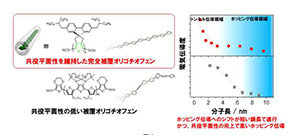
Plot Twist: Straightening Single-Molecule Conductors Improves their Performance
Researchers at Osaka University synthesize and measure the electronic properties of an insulated molecular wire in both its flat and twisted conformations
A team at Osaka University has created single-molecule nanowires, complete with an insulation layer, up to 10 nanometers in length. When they measured the electrical properties of these nanowires, the researchers found that forcing the ribbon-like chains to be flat significantly improved their conductivity compared with a twisted conformation. The findings may allow for a new generation of inexpensive high-tech devices, including smartphone screens and photovoltaics.
Carbon-based polymers, which are long molecular chains made of repeating units, can be found everywhere, from the rubber in the soles of your shoes to the proteins that make up your body. We used to think that these molecules could not conduct electricity, but that all changed with the discovery of conducting polymers. These are a small subset of carbon-based molecules that can act like tiny wires owing to their alternating single and double chemical bonds, also called conjugated bonds. Since carbon-based conductors are much easier and cheaper to make and customize than conventional electronics, they have seen rapid adoption in OLED TVs, iPhone screens, and solar panels, while drastically reducing their cost.
Now, researchers at Osaka University have synthesized chains of oligothiophene of various lengths, with up to 24 repeat units. This means that single nanowires could be up to 10 nanometers in length. Insulation of the wires was needed to avoid interwire currents, so that the intrinsic conductivity of a single molecule could be measured accurately. On the basis of the rules of quantum mechanics, electrons in molecules behave more like spread-out waves than localized particles. The overlapping bonds in oligothiophene allow electrons to be entirely spread out over the polymer backbone, so they can easily transverse the molecule to create an electrical current.
This charge transport can occur is two very different ways. “Over short distances, electrons rely on their wave-like nature to ‘tunnel’ directly through barriers, but over long distances, they hop from site to site to reach their destination,” first author Dr. Yutaka Ie explained. The team at Osaka University found that changing the oligothiophene chain from twisted to flat led to much greater overlap of the conjugated backbone of oligothiophene, which in turn meant a larger overall conductivity. As a result, the crossover from tunneling to hopping conduction took place with flat chains at shorter chain lengths, compared with those with the twisted conformation.
The researchers believe that this work can open a whole new world of devices. “This study demonstrates that our insulated nanowires have the potential to be used in novel ‘single-molecule’ electronics,” lead author Dr. Yoshio Aso said.

Fig 1 (Left) Chemical structures of completely insulated molecular wires derived from oligothiophene with nanometer length scales. The upper figure shows the flat conformation, while the lower figure displays the twisted form. (Right) Results of single-molecule conductance measurements, in which the conductivity is plotted as a function of oligomer length. The crossover from the tunneling regime to the hopping regime occurs at a shorter chain length in the flat nanowires owing to their increased conductivity.
The work is published in The Journal of Physical Chemistry Letters as “Highly Planar and Completely Insulated Oligothiophenes: Effects of π-Conjugation on Hopping Charge Transport.” (DOI: https://doi.org/10.1021/acs.jpclett.9b00747 )
Related links
